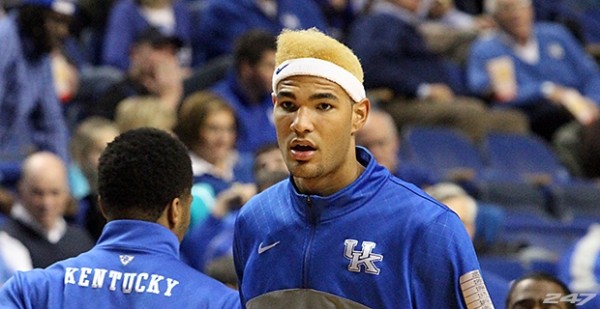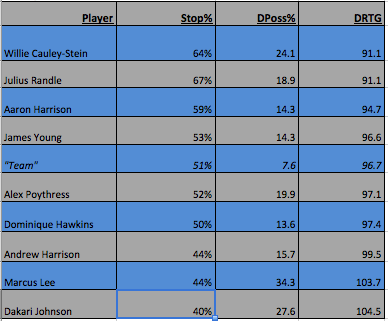Freeze Frame: Analyzing Kentucky’s Porous Defense
Posted by Brian Joyce on December 16th, 2013Kentucky started out the season with delusions of a perfect 40-0 season, a fantasy even more preposterous as we look back now. The fact is that this young team is a work in progress with imperfections that need to be addressed and a resume that needs polishing. In its three losses this season, Kentucky’s defensive struggles were highlighted and exposed for the nation to see. Luckily for these Wildcats, John Calipari has been here before and he has a lot of time to work out his team’s inefficiencies on the defensive end.

Willie Cauley-Stein is an elite defender with or without his blonde hair. (Photo courtesy of Kentucky247sports).
To analyze the trends ailing this inexperienced squad and to quantify their individual performances on the defensive end of the floor, I have charted every defensive possession in all 11 Wildcats’ games thus far. The analysis below represents the good, the bad, and the ugly in Kentucky’s defensive score sheet this season.
The Good News
Kentucky’s interior rim protection has been a bright spot, erasing a multitude of mistakes in the Wildcats’ perimeter defense. Both Willie Cauley-Stein and Julius Randle have an impressive defensive rating, a metric calculated to represent the number of points allowed by an individual defender over 100 possessions. Cauley-Stein and Randle lead the team with 91.1 defensive ratings, with Cauley-Stein as a high usage defender involved in nearly 25 percent of the Wildcats’ defensive possessions.
Kentucky’s defensive score sheet to this point reveals why Calipari loves Aaron Harrison’s defensive abilities. The shooting guard sits near the top of Kentucky’s defensive rankings with a 59 percent stop percentage (a figure that represents the percentage of defensive possessions in which a defender contributes to a defensive stop either through a forced turnover or forced missed shot). The defensive score sheet also offers a glimpse into the reasoning behind Dominique Hawkins’ increase in minutes. His perimeter defense continues to earn him playing time in the talented backcourt.
The Kentucky bigs have been phenomenal in protecting the rim close to the basket. Because of the length and shot-blocking abilities of Cauley-Stein, freshmen Dakari Johnson and Marcus Lee, and the ever-improving Alex Poythress, the Wildcats are 14th in the country in defensive field goal percentage near the rim, limiting opponents to 48.8 percent shooting there.
The Bad News
It certainly hasn’t been all rainbows and butterflies for the Wildcats, though, as stopping penetration from the perimeter has plagued them all season long. In particular, the area causing Kentucky the most trouble has been the exposure of flaws in the Wildcats’ pick-and-roll defense. Against Baylor, players didn’t switch on the perimeter in the first half, causing a lot of miscommunication between the Kentucky defenders. In this first play, Cauley-Stein and Andrew Harrison both go with the ball-handler, leaving the screener open for an easy slam.
In another play during that half, Cauley-Stein tries to hedge on the ball-handler and then return to guard Baylor’s Cory Jefferson but gets caught in a screen-the-screener situation. Jefferson sets the pick on Kentucky’s Harrison and then Brady Heslip comes up to the top of the lane to set a back screen on Cauley-Stein to prevent the shot-blocker from following the athletic Jefferson. The result is another easy dunk for Baylor.
Against UNC, Kentucky switched on all screens, creating a new series of challenges. In this first play, Randle doesn’t hedge at all and gets caught backing up towards the basket. The only problem is that James Michael McAdoo realizes Randle is out of position to pressure his shot and stops for the open jumper.
The other problem that occurred as Kentucky switched on all screens during the North Carolina game is that it left UK defenders in several mismatches. In this pick-and-roll, Randle and Harrison switch, leaving Harrison to guard the much taller McAdoo, guarded originally by Randle. This left McAdoo in a post-up mismatch, greatly favoring the Tar Heels.
The Ugly News
Kentucky’s poor transition defense has been mostly a product of too many turnovers on the offensive end and poor effort than anything else. In a victory against Eastern Michigan, the Wildcats turned the ball over near the free throw line. Rather than recover quickly to get back and play defense, Kentucky allowed the Eagles to turn the possession into an easy four-on-one fast break.
A similar scenario occurred in Chapel Hill when the Wildcats turned the ball over. Several Wildcats got back on defense, but those who did failed to stop the ball and fill the passing lanes, allowing for an easy bucket for UNC.
The individual defensive performances of Cauley-Stein and Aaron Harrison give Kentucky something to build upon in improving its defensive efficiency. Calipari will work to iron out the Wildcats’ pick-and-roll and transition defense while attempting to get more effort out of Andrew Harrison on the perimeter. His team is young and inexperienced, of course, but that is nothing new for Calipari. Lockdown defense has been a trademark of his Kentucky teams in his short tenure in Lexington, and it says here that Calipari will shore up many of these defensive miscues by March. There is too much talent, length, speed, and shot-blocking ability on this roster for it to not eventually become an elite defensive unit. And when that happens, watch out.















































[…] Rush The Court analyzes Kentucky’s porous defense […]
Thanx for ur Thorough work. I hope sooner than March but will settle.
As a huge UK fan I appreciate an unbiased look at my team. Great article!
[…] Good breakdown of Kentucky’s defensive struggles so far this year. [Rush the Court] […]